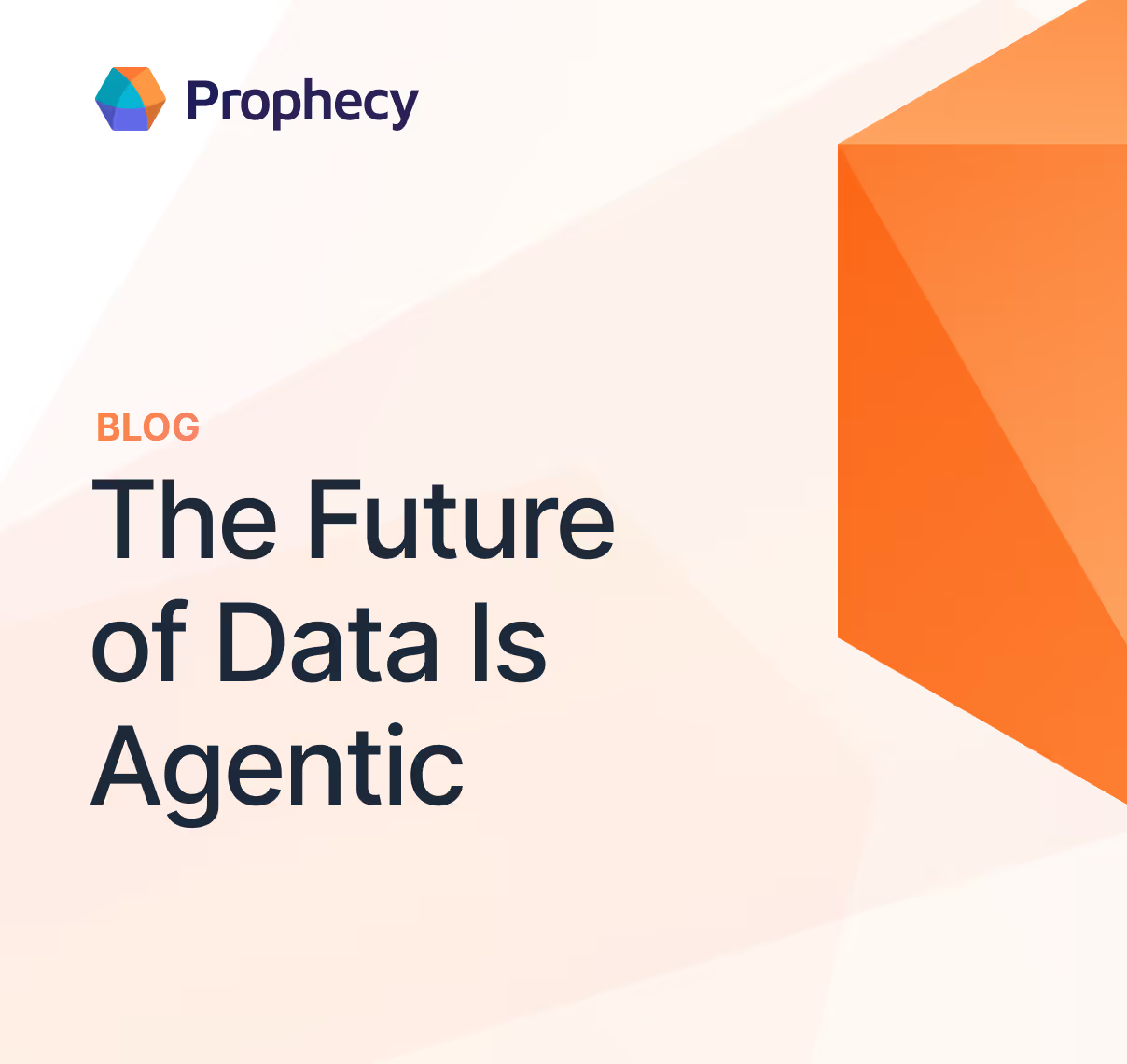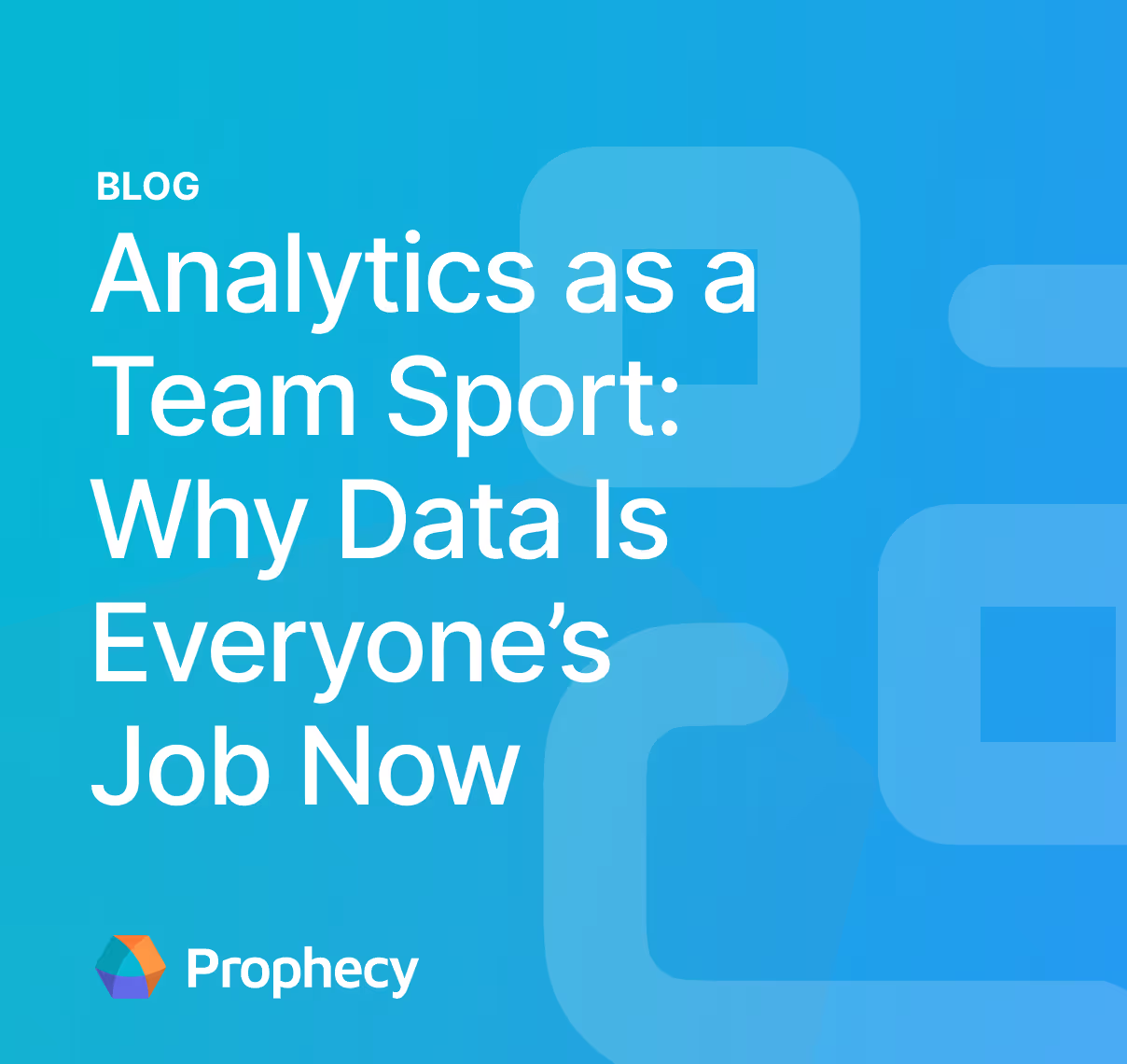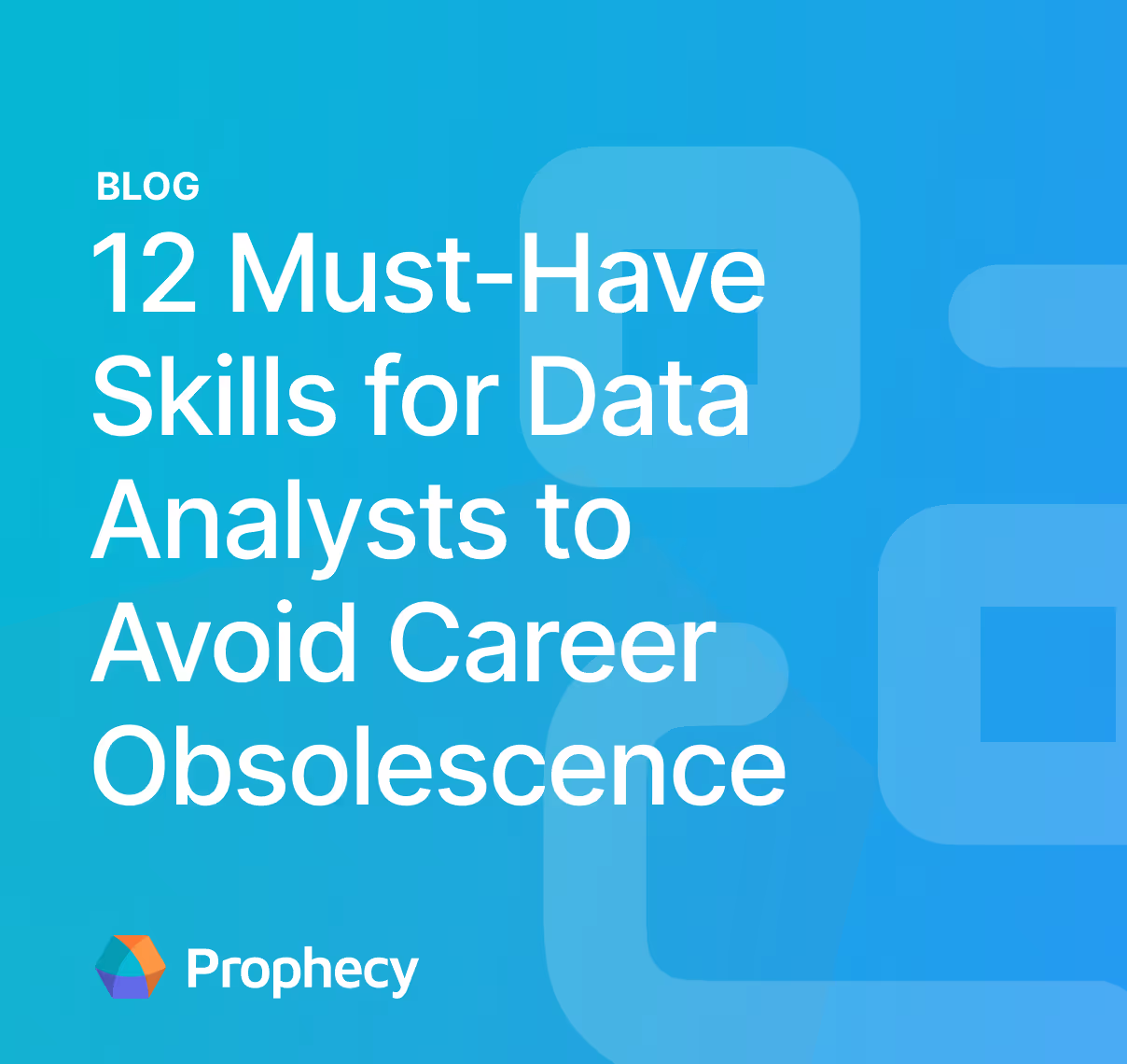The End-to-End Analytics Lifecycle: From Ingestion to Insight
Explore the full analytics lifecycle, from data ingestion to insights, and learn how to solve the main bottleneck that impacts every stage.
Why do so many analytics projects get stuck, even after you've bought the best tools and hired a great team?
The answer often lies not in what you see, but in the unseen work of the analytics lifecycle.
Successfully delivering business value through data requires organizations to move beyond a focus on dashboards and, instead, strategically orchestrate the entire analytics lifecycle—from data ingestion and transformation to analysis and delivery—by bridging the collaboration gap between business and technical teams.
Why the full analytics lifecycle matters
Most organizations focus their analytics investments on the wrong end of the process. They buy visualization tools, hire dashboard developers, and wonder why their data initiatives still take months to deliver business value. Meanwhile, their data teams spend most of their time on the invisible work that happens before any chart gets created.
This disconnect creates the classic analytics dilemma, where business stakeholders get frustrated by slow delivery times, and technical teams are overwhelmed by repetitive data preparation tasks. The solution isn't better dashboards—it's better orchestration of the entire analytics lifecycle.
The five stages of data analytics
Before any technical work begins, successful analytics projects start with two fundamental questions: What specific business problem are we trying to solve, and what data sources contain the information we need to solve it? This upfront scoping determines whether your analytics effort will deliver real value or become another abandoned dashboard. Once you've clearly defined the business problem and identified your relevant data sources, you can begin the analytics process.
While there are various strategies for data analytics, most include these five interconnected stages:
1. Data ingestion
Data ingestion establishes the foundation of your analytics capability by collecting raw data from diverse sources across your organization. This stage involves connecting to operational databases, integrating with third-party APIs, processing file uploads, and capturing real-time event streams. The ingestion process must handle varying data formats, frequencies, and volumes while ensuring data integrity and security.
Your entire analytics capability depends on reliable, consistent data ingestion. When this stage breaks, everything downstream stops working, making this the most critical layer of your analytics infrastructure.
Common bottlenecks in this stage include:
- Integration complexity: Each new data source may require custom connection logic, authentication, and error handling. What starts as a simple data connection quickly becomes a maintenance burden as you manage dozens of different integration patterns.
- Data quality issues: Inconsistent formats, missing values, and unexpected schema changes can break downstream processes without warning. Poor data quality at ingestion multiplies exponentially through every subsequent stage of your analytics process.
- Scalability challenges: Systems that work perfectly for small data volumes may fail as your organization grows. Network bandwidth, processing capacity, and storage limitations create bottlenecks that weren't apparent during initial implementation.
- Security and compliance: Ensuring sensitive data is properly handled from the moment it enters your ecosystem requires complex access controls, encryption, and audit trails. A single security breach or compliance violation can compromise your entire analytics program and create significant legal and financial risks.
2. Data transformation
Raw data arrives messy, inconsistent, and scattered across formats that make analysis difficult. Transformation work bridges this gap. Teams clean inconsistent values, standardize data types, apply business rules for categorization and validation, then join datasets from multiple sources into comprehensive analytical foundations. The complexity lies in implementing logic that handles missing data, resolves duplicates, calculates derived metrics, and maintains consistency across different source systems, all while preserving the business meaning embedded in the original data.
The transformation stage requires deep collaboration between business domain experts who understand what the data means and technical experts who implement the transformation logic. It often becomes the most complex part of your analytics infrastructure because it must encode both technical data manipulation and nuanced business logic.
Common bottlenecks in this stage include:
- Translation errors: Business requirements can get lost in translation between domain experts and technical implementers, leading to transformation logic that doesn't reflect actual business needs. These misalignments often aren't discovered until the final insights are delivered and stakeholders realize the results don't match their expectations.
- Request backlogs: Data engineering teams may become bottlenecks as every new business question requires custom transformation logic. What should be routine data preparation tasks turn into weeks-long development cycles.
- Technical debt: Quick fixes and one-off solutions can accumulate over time, making the transformation layer increasingly fragile and difficult to maintain. Each new requirement forces developers to work around previous shortcuts, compounding complexity.
- Documentation gaps: Transformation logic often becomes tribal knowledge that only original developers understand, making updates and maintenance risky. When key team members leave, entire transformation processes become black boxes that nobody dares to modify.
3. Data analysis and modeling
Analysis and modeling transform clean data into business intelligence through both exploratory investigation and mathematical framework creation. Teams start by analyzing patterns, trends, and relationships within datasets—conducting statistical tests, identifying correlations, and validating hypotheses about business performance. This exploratory work then informs the development of predictive models, from simple forecasting algorithms to complex machine learning systems.
Success in this stage requires both deep analytical expertise and comprehensive business domain knowledge to ensure models solve real problems rather than just technical exercises. Data scientists must work closely with business stakeholders to understand the context behind the numbers, validate model assumptions against real-world experience, and align analytical approaches with business objectives and constraints.
Common bottlenecks in this stage include:
- Skill gaps: Advanced analytical techniques require specialized expertise in statistics, machine learning, and domain-specific modeling that's often scarce in organizations. Finding professionals who combine technical modeling skills with business acumen creates hiring challenges and knowledge bottlenecks.
- Model governance: Ensuring models remain accurate and relevant as business conditions change requires ongoing monitoring, validation, and updates that many organizations struggle to implement systematically. Models can degrade silently over time as underlying data patterns shift, leading to increasingly unreliable insights.
- Performance optimization: Models that work perfectly in development environments with small datasets may be too slow for production use with real-world data volumes and latency requirements. Complex algorithms that provide marginal accuracy improvements can create unacceptable delays in business processes that need real-time insights.
- Version control: Managing changes to analytical logic without breaking existing reports, dashboards, and automated systems requires careful coordination and testing. Without it, a single model update can cascade through dozens of downstream applications, creating unexpected failures or inconsistent results.
4. Insight generation
The insight generation stage is where analytical outputs get transformed into business-ready insights. Teams run the models and analyses built in the previous stage, then interpret the raw results to extract meaningful findings. Then, analysts check results against known benchmarks, test for statistical significance, ensure findings can be reproduced, and collaborate with business experts to confirm that insights align with real-world experience.
This stage is often underestimated because it requires not just analytical skills, but the ability to communicate complex findings clearly, qualify results appropriately, and provide the business context that transforms a statistical output into a strategic insight that can actually drive decisions.
Common bottlenecks in this stage include:
- Context gaps: Technical results that lack business context create confusion for decision-makers. Without explaining what findings mean for strategy or operations, stakeholders can't act on insights, forcing multiple rounds of clarification meetings and delaying decisions.
- Quality assurance: Without clear standards for what constitutes "good enough" analysis, teams spend weeks debating methodology while business opportunities pass by. Every insight becomes a custom review process involving multiple stakeholders and extended approval cycles.
- Timeliness: Lengthy validation processes mean business conditions often change before insights are approved, making analysis irrelevant. What should be actionable intelligence becomes historical curiosity, forcing teams to restart with updated data.
- Reproducibility: When analyses can't be recreated or understood by others, organizations lose confidence in insights and must rebuild work from scratch. Poor documentation multiplies effort and creates delays when key analysts leave or methods need updating.
5. Delivery
Insights mean nothing if they don't reach the right people at the right time in the right format. This final stage packages analytical findings into dashboards, reports, alerts, and embedded applications that fit into existing business workflows. The real challenge isn't building beautiful visualizations—it's ensuring insights actually drive decisions and measurable business actions rather than just getting viewed and forgotten.
Effective delivery depends on a deep understanding of how decisions actually get made within the organization. Teams must know whether executives prefer high-level summaries or detailed breakdowns, whether operational managers need real-time alerts or weekly reports, and whether insights should trigger automated actions or manual reviews. Success means matching insight delivery to the specific decision-making workflows where they'll actually be used.
Common bottlenecks in this stage include:
- Format mismatches: Insights delivered in formats that don't match how business stakeholders actually work create friction that prevents action. For example, executives who need quick summaries may receive detailed technical reports, while operational managers who need drill-down capabilities get static PDFs.
- Information overload: Too many metrics without clear prioritization or actionable guidance overwhelm decision-makers and dilute focus from what actually matters. Dashboards with dozens of KPIs create analysis paralysis rather than clarity, making important signals get lost in the noise.
- Feedback loops: Difficulty measuring whether insights actually influenced decisions or outcomes makes it difficult to improve delivery effectiveness over time. Teams can track dashboard views but have no visibility into whether insights changed strategies or drove operational improvements.
- Maintenance burden: Reports and dashboards that require constant manual updates consume analytical resources and create reliability issues that erode stakeholder trust. When visualizations break or require weekly manual refreshes, teams spend more time maintaining delivery mechanisms than generating new insights.
Understanding the common bottleneck across stages
While each stage has its unique challenges, one bottleneck appears consistently across the entire analytics lifecycle: the collaboration gap between business teams and data teams. Look closely at the most common pain points:
- Translation errors in data transformation happen when business requirements get lost between domain experts who understand what data means and technical teams who implement the logic.
- Context gaps in insight generation occur when analysts produce technically sound results that lack the business interpretation needed for decision-making.
- Format mismatches in delivery arise when technical teams build what they think stakeholders need rather than what actually fits their workflows.
- Even seemingly technical bottlenecks like request backlogs stem from collaboration breakdowns—when business teams can't express their needs in ways that technical teams can efficiently address, every routine request becomes a custom development project.
This pattern highlights that most analytics delays aren't caused by computational complexity or technical limitations. They're caused by the friction between people who understand the business and people who understand the technology.
Reduce friction between teams with the right tools and approach
Modern analytics platforms enable business users to perform routine data transformations through visual interfaces while automatically generating the robust, production-ready code that technical teams require. AI-powered guidance helps bridge knowledge gaps, suggesting transformations and catching errors before they propagate downstream. Most importantly, collaborative workflows let business and technical teams work on the same problems using interfaces suited to their expertise, rather than forcing one group to adapt to the other's tools.
When collaboration friction disappears, the entire analytics lifecycle accelerates. Business teams get the independence they need to answer routine questions quickly, while technical teams can focus on building scalable infrastructure and solving complex analytical challenges rather than fulfilling repetitive requests.
Bridge the analytics collaboration gap with Prophecy
Prophecy addresses data collaboration challenges by providing a unified platform where business teams and data engineers can work together seamlessly throughout the entire analytics lifecycle. Rather than forcing one group to adapt to the other's tools, Prophecy creates a shared workspace where business users can build data transformations visually while technical teams get the robust, production-ready code they need.
Here's how Prophecy specifically tackles the friction points in your analytics workflow:
- Visual-Code dual interface: You get the best of both worlds with Prophecy's unique approach, where business analysts can drag and drop to build data pipelines using an intuitive visual interface, while data engineers can work directly with the automatically generated Spark, Python, or SQL code.
- Intuitive AI agent: Instead of lengthy requirement-gathering meetings where business needs get lost in translation, your teams can use natural language to describe what they want to accomplish. Prophecy's AI understands these requests and suggests appropriate transformations, generates test cases, and even explains complex logic in plain English.
- Enterprise governance: You don't have to choose between speed and compliance. Prophecy integrates directly with your existing security frameworks like Unity Catalog, automatically enforces data governance policies, and maintains complete audit trails—all while enabling self-service capabilities.
- Git-based collaboration: Your business and technical teams can collaborate on the same data projects using familiar workflows, with complete change tracking and the ability to roll back modifications if needed.
Learn more about what challenges may be slowing your data team down and affecting collaboration with our ebook, Five Dysfunctions of a Data Team.
Ready to give Prophecy a try?
You can create a free account and get full access to all features for 21 days. No credit card needed. Want more of a guided experience? Request a demo and we’ll walk you through how Prophecy can empower your entire data team with low-code ETL today.
Ready to see Prophecy in action?
Request a demo and we’ll walk you through how Prophecy’s AI-powered visual data pipelines and high-quality open source code empowers everyone to speed data transformation
Get started with the Low-code Data Transformation Platform
Meet with us at Gartner Data & Analytics Summit in Orlando March 11-13th. Schedule a live 1:1 demo at booth #600 with our team of low-code experts. Request a demo here.
Related content
A generative AI platform for private enterprise data
Introducing Prophecy Generative AI Platform and Data Copilot
Ready to start a free trial?
Lastest posts

The Future of Data Is Agentic: Key Insights from Our CDO Magazine Webinar

Analytics as a Team Sport: Why Data Is Everyone’s Job Now




